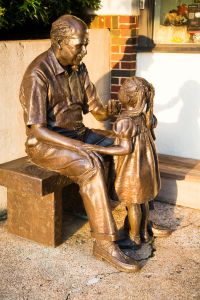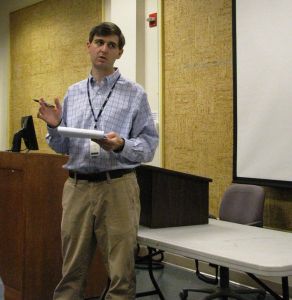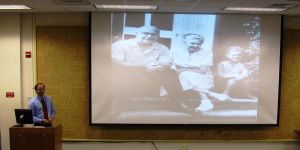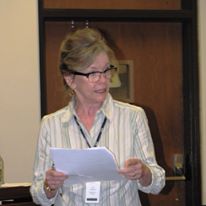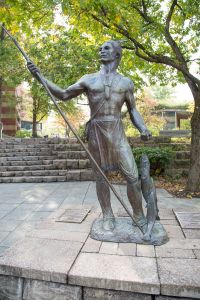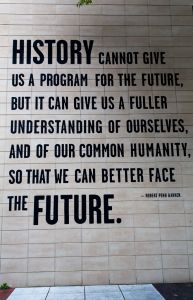more
main page | more
Below you can find summaries of each panel at our first conference.
1. The Great War
Opening the conference with his paper entitled “Dos Passos’s One Man's Initiation: Facial Mutilation and the End of Medieval Idealism,” Aaron Shaheen (University of Tennessee at Chattanooga) argued that the author’s debut novel shows a clear preoccupation with the human face and forms of facial mutilation. This preoccupation, he explained, suggests the modern world’s sharp break with the Middle Age’s neo-Platonic idealism. During the Middle Ages, as the paper contextualized, the very face of Christ served as an objective correlative for Truth and Christian virtue. Yet in the age of mechanized warfare, facial prosthesis, and gas masks, this idealism has been replaced by a materialism that has no spiritual analogue, a materialism that cannot transcend itself.
In the following paper, “Initiation to the New Symbolic: One Man’s Initiation and Lacanian Psychoanalytics,” Julia Hunter (University of Tennessee at Chattanooga) examined images of decay in One Man’s Initiation, focusing especially on the deterioration and in version of concepts associated with literature and high culture in the wake of the war. Drawing on the theories of Jacques Lacan, she suggested that the novel could be seen to dramatize a violent clash between the Real (the war) and the Symbolic (Western culture as it once was), precipitating the creation of new cultural identifiers and a new world. Martin Howe’s initiation, the paper argued, represents the entry into this new world, a passage that is also reinforced at the level of focalization.
In the last paper of the panel, “Three Soldiers: The Revolution Will Be Working-Class and Queer,” James Arnett (University of Tennessee at Chattanooga) argued that Dos Passos in Three Soldiers envisions a revolutionary role for the working class soldier that dovetails with a brief fascination in his novels with queer male desire (which also makes a notable appearance in Manhattan Transfer). The result is a brief, apocalyptic vision of a revolutionary overthrow of capitalist technes of repression and violence by an alliance between working class and queer subjects, which, although ultimately foreclosed as possible, nevertheless engenders the spectral potential of such collaboration.
2. Contemporaries
Dean Bartholomew, an independent scholar, began the session with “Dos Passos/Hemingway: A Broken Friendship.” The presentation noted the many similarities between the two writers; they both drove ambulances in World War I, and their interest in socialist and communist causes drew them to the Spanish Civil War in the 1930s. Bartholomew then detailed the growing tension between the two, which reached a head in Spain over the mysterious disappearance of Dos Passos’s friend José Robles, and the icy relationship that existed in later decades. While Hemingway may have proven the better writer, the presentation concluded, Dos Passos proved to be the better person.
Amy Schmidt (Lyon College) then offered a reassessment of Ernest Hemingway’s second wife in “40 Plus Coats of Paint: Pauline Pfeiffer-Hemingway as an (Almost) Delta Debutante.” Schmidt argued that literary scholars often present Pauline Pfeifer-Hemingway as either a man-hunting home-wrecker or a submissive and prudish wronged wife. However, read another way, she more resembled a Delta debutante, who dressed impeccably and socialized graciously. Lest this persona made her out to be shallow, her articles for Vogue demonstrate a sharp wit, and her African diary illustrates an ironic and sometimes wicked sense of humor. Both her wit and her humor kept John Dos Passos and others coming back to Key West for some time after her husband Ernest had begun alienating them.
In the closing paper of the panel, entitled “John Dos Passos and Pío Baroja: Agents of Revolution,” David Murad (Lakeland Community College) claimed that in the writings of Baroja Dos Passos had found a model in style, script, and attitude for his own art and approach to writing—not just in Rosinante to the Road Again, but in all the social commentary and novels leading up to his own U.S.A. trilogy. Although a few critics have noted Baroja’s influence on the young and maturing Dos Passos, Murad’s presentation revealed just how important Baroja was as Dos Passos became his American counterpart, an agent and artist of revolution.
3. Manhattan Transfer
In her paper entitled “Politics and the Spanish Reception of John Dos Passos,” Rosa María Baustista Cordero (Universidad Alfsonso X el Sabio) focused on Dos Passos’s reaction to the Spanish Civil War and Spain’s relationship with Dos Passos’s work. She argued that the Spanish Civil War played a determining role in the reception of John Dos Passos as a writer both in America and in Spain. However, in the US, Dos Passos’s political shift afterwards made him less popular among critics, fellow writers and the reading public, while in Spain, José Robles’ death linked Dos Passos and Manhattan Transfer to Spanish historical and cultural identity.
In the paper that followed, “Manhattan Transfer, Camilo José Cela and Twentieth-Century Spanish Fiction,” Pedro F. Campa (University of Tennessee at Chattanooga) addressed the influence of Dos Passos and his importance in post-Civil War Spanish fiction. Campa argued that the figure of John Dos Passos continues to hold a prominent place in Spanish history because of his involvement on the Republican side of the Spanish Civil War and the popularity of his books. Dos Passos’s montage technique, rapid dialogue, disconnected narratives and the apparent disregard for the traditional structure of the novel had a profound influence on one of the most important Spanish novelists of the twentieth century, Camilo José Cela, to whose work Campa compared and contrasted the work of Dos Passos.
Following Dr. Campa’s presentation, we heard from William Brevda (Central Michigan University), whose paper entitled “The Hat in Manhattan Transfer” focused on fashion trends as they are depicted in the novel. Brevda discussed ritualized men’s fashions—particularly in relation to hats, and drew comparisons between Manhattan Transfer and an avant-garde documentary, Manhatta.
To close, we heard from Katherine Ryan (University of California at Irvine). Her paper, “A ‘Fire that Purifies’: Psychic Contamination and Suicidal Fantasy in Manhattan Transfer,” analyzed the fire motif in the novel to suggest that the problematization of individual agency in the urban sphere is highlighted by depictions of suicide in the novel. She argued that fire, and its uncontrollable transmission within and across vignettes, comes to stand in for an inescapable psychic contagion.
4. Film
In her paper entitled “‘Goin’ to the movies…?’: Picturing the War in Three Soldiers,” independent scholar Lisa Nanney studied Three Soldiers for its visual aesthetics, finding that it is no “apprentice novel” but instead prepares the formal devices of Manhattan Transfer and U.S.A. The novel establishes the significance of film as both a structural principle and a thematic pointer, she concluded.
In the following paper, “Dos Passos and Sender: Cinematography and the City,” Lynn C. Purkey (University of Tennessee at Chattanooga) discussed the reception of Dos Passos’s work in Spain in the 1920s and 30s, when Manhattan Transfer received the greatest critical attention of his works. She studied the formal connections between this novel and Ramón J. Sender’s Siete Domingos Rojos (1932), a surrealist novel that uses techniques similar to those of Manhattan Transfer and The 42nd Parallel.
To close the panel, Edward Eason (University of California at Riverside) presented his paper entitled “‘A Time of Mourning…Too Meaningful and Tragic for Applause’: Capturing the Spectacle of Peace through Silent Film Aesthetics in John Dos Passos’s 1919.” Here, Eason argued that 1919 manifests wartime’s continuity into the presumed peace of the 1920s through silent film aesthetics, with particular attention to the prayer for the burial of the Unknown Soldier. This passage, he found, illuminates the obscured continuity between the shock of wartime and the spectacle of peace.
5. The Feminine
Natalie Counts (Chattanooga State Community College) began the session with “Rejection of Repressive Symbolism in 1919: Dos Passos’s Eveline Hutchins.” In it she argued that Eveline’s refusal to be categorized and reduced to any number of symbols of womanhood pushes the envelope of gender roles; however, her ultimate acquiescence to motherhood reveals the limitations of such movement. Still, Eveline’s character is one of Dos Passos’s successes as he navigates what it means to be a woman in a post-World War I world. He shows Eveline raging against repressive representation, if only to explore how deeply worn the grooves of symbolism truly are.
In “Margo Dowling: Giver and Taker” Claudia Matherly Stolz (Urbana University) argued that Margo, a key female character featured in The Big Money, is one of Dos Passos’s most intriguing creations, as she demonstrates Dos Passos’s intuitive knowledge of the symptoms and long-term effects of sexual abuse during a point in history that such criminal acts were swept under the rug. The author also weaves into Margot’s story the will to succeed, by any means, even though a woman, and ultimately shows that women have the capacity to become as ruthless as men if given the opportunity. In addition, the novel addresses the budding Hollywood industry, of which Margo is a participant, and its crushing effect on lives, fictional and real, during the transition from silent film to talkies.
Finally, in “From Left to Right: Political Economy and Female Mobility in Dos Passos’s U.S.A. and District of Columbia Trilogies” Paul Petrovic (University of Tulsa) focused on what it means that The Grand Design’s Georgia Washburn echoes The Big Money’s Mary French, especially with regard to their limitations in society. Noting the nearly fifteen-year span of time that exists between the publication of the two novels, Petrovic sought to return to the two trilogies the gender oppression and attendant resistance that informs them, regardless of their author’s political shift from left to right. Both texts record an affront to the emergent politics of gender equality, as both characters are derided by the dominant ideology to which they subscribe.
6. U.S.A.
The panel began with Victoria Bryan (Cleveland State Community College), who gave a paper entitled “‘Truth? What Is Truth?’: John Dos Passos and Prison Writing.” Drawing on archival research from the University of Virginia, Bryan argued that Dos Passos developed a vested interest in prisons and incarceration during the 1920s and 30s. She discussed ways in which this little-studied focus within his writing furthers our understanding of his radical years, throwing him into conversation with some of the earlier prison writing coming out of America’s jails and prisons at the beginning of the 20th century. Among the topics she discussed were the biographies of Eugene Debs and Sacco and Vanzetti in the U.S.A. trilogy (which demonstrated a respect for the men involved in the prison system in various ways) and various unpublished manuscripts that show Dos Passos grappling with the United States’ problematic systems of incarceration.
In the following paper, entitled “Re-assessing War and Manliness: Dos Passos’s Critique of Theodore Roosevelt in 1919,” Keiko Misugi (Kobe College) discussed how Dos Passos reassesses war and manliness through this ironic representation of Roosevelt. Focusing on Dos Passos’s critique of his bellicose ethos, she situated Roosevelt’s biographical sketch in Dos Passos’s desire to reconfigure manliness for a modern world.
In the last presentation, "Intimations of Empire: Dos Passos Titles the U.S.A. Trilogy," Fredrik Tydal (University of Virginia) drew on his archival studies to discuss Dos Passos's alternative title for the trilogy: "Course of Empire." He teased out the intertextual echoes that would have been created by that title, and speculated about what place the U.S.A. Trilogy would have in American literary history had Dos Passos Chosen the alternate title.
7. Teaching Roundtable
This roundtable featured four presentations that explored innovative ways of advancing the mission of the John Dos Passos Society—to promote interest in Dos Passos’s work through teaching and scholarship.
In “Anthologizing Dos Passos,” research by Wesley Beal (Lyon College) revealed that literature anthologies commonly used in college courses do not currently include sufficiently representative samples of Dos Passos’s narrative modes in U.S.A. To introduce students to the “formal dynamism” that makes U.S.A. unique, Beal proposed an anthology that includes an example of each mode representing the same historical moment, thus illustrating the “complicated interplay” among the narrative devices. Seeing how the text refracts one event from the various angles afforded by the modes can alert students to the distinctive kind of “narrative work” each mode does yet help students understand also the relationships among the modes.
Victoria Bryan (Cleveland State Community College) related insights she gained while teaching both autobiography and fiction by Dos Passos to students at a correctional institution. In “Teaching Dos Passos’s Radical Works in the Prison Classroom,” Bryan discussed how she used portions of U.S.A. about political cases important to Dos Passos—such as the Sacco-Vanzetti trial—with incarcerated students whose distinctive experiences enable their engaged readings of these texts. She also outlined pedagogies she evolved to encourage incarcerated learners in a life writing class to create their own autobiographies after exploring narrative choices Dos Passos and Hemingway make in theirs.
Using visual art as part of his strategy to help students overcome difficulties common to reading Dos Passos’s fiction, Aaron Shaheen (University of Tennessee, Chattanooga) explored “The Triumphs and Challenges of Teaching Dos Passos.” Illustrating a shift from impressionist to expressionist representations in Dos Passos’s earlier fiction and asking students to explore rationales for the ordering of narrative elements in U.S.A., Shaheen helped students address the challenges posed by flat characters and mixed genres in the writer’s work.
The fourth panelist, Fredrik Tydal (University of Virginia), recounted the wealth of “Teaching Resources in the Dos Passos Archives.” Drafts of Dos Passos’s novels, Tydal demonstrated, reveal the writer’s creative processes. These preliminary manuscripts provide for students graphic representations of Dos Passos’s visual thinking, spatial organization, and character “mapping,” akin to verbal Cubist portraits.
8. Midcentury
In the opening paper, entitled “The Eroded Authority of Herbert Spotswood,” Jason Cannon (Texas Christian University) dealt with the comparatively neglected Adventures of a Young Man, focusing on its thematic engagement with American traditions of manhood. As Cannon argued, the novel could be seen to enact a crisis of masculinity, brought on by cultural changes in interwar America, which finds the paternal figure of Herbert Spotswood struggling to maintain both his social and familial position. Rather than only representing Dos Passos’s break with leftist politics, Cannon demonstrated that the novel could also provide much insight into changing gender roles and family dynamics of its time.
Next, in a paper entitled “John Dos Passos and The Great Tradition,” Robert Z. Birdwell (Penn State University) departed from the observation that Granville Hicks’s assessment of the U.S.A. trilogy remained constant throughout his life, even as the critic’s political views shifted dramatically to the right. The reason for this surprising continuity, Birdwell suggested, is because Dos Passos’s work itself affirms the progressive aesthetic and political criteria by which bourgeois writers of the great tradition, such as Henry James, can be evaluated. Through their fusion of realist and modernist styles, the paper argued, Dos Passos’s novels transcend conventional periodization, and thus continue to remain relevant.
Finally, in a paper entitled “John Dos Passos and the Mainstream of America,” Matt Seybold (University of Alabama) explored Dos Passos’s often overlooked involvement with Doubleday’s historical book series The Mainstream of America. Although the individual volumes Dos Passos contributed to the project are a familiar presence in his bibliography, they are seldom studied in the context of the series for which they were originally commissioned and produced. As Seybold argued, Dos Passos’s installments in the series could be seen as a unified historical trilogy in which the author celebrates many of the same mechanisms of nation-building – individualism, creative destruction, cultural entropy – which he treats with skepticism in the U.S.A. trilogy. Given relatively free reins by series editor Lewis Gannett, Dos Passos was able to grapple with the mythology of America on a large scale, while also historicizing his own experience.
9. Form
The final panel of the conference began with Alexander Buk-Swenty and Philip Gyde Poulsen (University of Southern Denmark), who presented “A Modernist Odyssey: Dos Passos’s Aesthetics and Intermedial Art,” comparing some of Dos Passos’s paintings to aspects of his narrative strategies and to early twentieth-century trends in visual aesthetics. The authors theorized that Dos Passos developed an increasingly modernist style in both visual and narrative works as “it became imperative for [him] to reconceive his art, independent of form, into fragmented parts in order to grasp the larger themes he intended to further anatomize.” They concluded that “as Dos Passos saw the U.S.A. as a multifaceted fata morgana . . . the only way he could encompass it was through a similarly multifaceted artistic lens.”
In the second presentation, Kirk Swenson (Georgia Perimeter College) explored “The Dialectic of Fear and Desire in U.S.A.’s ‘Camera Eye.’” Swenson finds Dos Passos a “satirist charged with moral purpose” who “adapt[ed] modernism to his satiric purpose.” Instead of the detachment that characterizes Joycean satire, Dos Passos’s narrative introduces via the Camera Eye a “critical consciousness that transcends the corruption dramatized in the other three modes and finally denounces it.” However, Swenson asks, what is the nature of the transcendence, “how is it effected, and who is the persona” of the device? The paper explored these issues in the context of the “dialectic . . . between . . . the ‘grotesque’ and the ‘classical body’” in the Camera Eye.
The third presentation, “Modernization and Form in Brazil on the Move,” by Gabriela Siquiera Bitencourt (Universidade de São Paulo), focused on how Dos Passos in this 1963 travel book gave narrative form to a country at a pivotal time in its history—“the years between the end of a dictatorship and the beginning of another.” Bitencourt explored the ways in which Dos Passos conveyed the politics and the promise of this country’s “modernization process” through his observations about the country, the people, and in particular the “public projects” he viewed while there.
